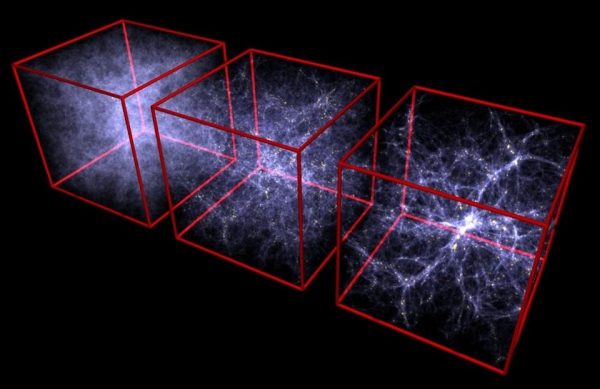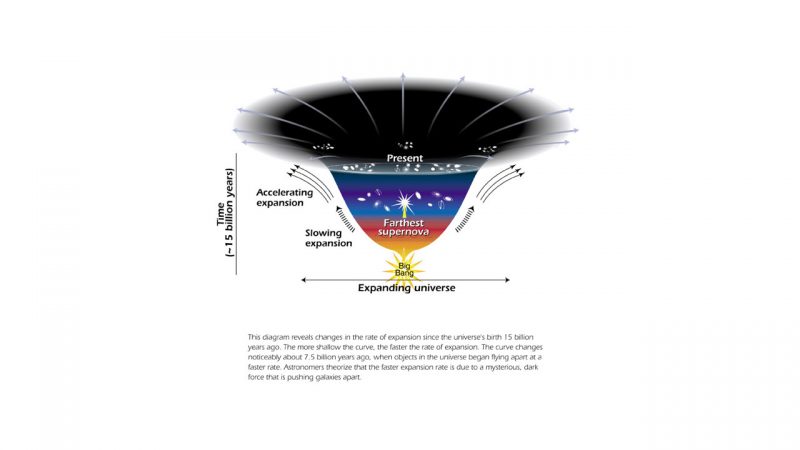
Dark energy is the name given to the mysterious force that’s causing the rate of expansion of our universe to accelerate over time, rather than to slow down. That’s contrary to what one might expect from a universe that began in a Big Bang. Astronomers in the 20th century learned the universe is expanding. They thought the expansion might continue forever, or eventually – if the universe had enough mass and therefore enough self-gravity – reverse and cause a Big Crunch. Now, in early 21st century cosmology, that idea has evolved. The universe is seen as expanding faster today than billions of years ago. What could be causing the rate of expansion to increase? Astronomers now sometimes speak of a repulsive force as a possible way to understand it.
Up until the late 1990s, most cosmologists believed the universe did not have enough mass to cause a Big Crunch. In particular, data acquired by the 2dF Galaxy Redshift Survey and the Sloan Digital Sky Survey seemed to confirm the universe would expand forever, albeit at an ever-slowing rate as the universe’s own mass and own gravity tried to pull it back.
The first indication of something revolutionary about to be discovered came in 1998 during a survey of Type 1A supernovae. These massive explosions of dying giant stars are extremely useful to astronomers because they always output the same amount of light, and can therefore be used as so-called “standard candles” to calculate distances in the cosmos. This is a very simple idea. Think of fireflies at night: they all shine with the same instrinsic brightness. By measuring how bright they are from where you are, you can calculate their distance.
The 1998 survey was being carried out by two international group of astronomers including Americans Adam Riess and Saul Perlmutter, and Brian Schmidt in Australia. Using eight telescopes worldwide, their aim was to use the distance of Type 1A supernovae to calculate the expansion rate of the universe, known as the Hubble Constant (although in reality, as the rate of expansion of the universe varies with time, it is technically not a constant).
The results of the survey were astonishing. Distant supernovae which exploded when the universe was only 2/3 of its current age were much fainter than they should have been, and were thus much further away. The implication of this was that the universe had expanded much faster than it should have done, if current ideas were correct.

Met with much skepticism in the astronomical community when these results were revealed, the observations were soon replicated by other teams and other methods. By the turn of the millennium, it was becoming clear that the expansion of the universe is not, as was commonly believed, slowing down. It is actually accelerating.
Even more strangely, the expansion had been deaccelerating, as one would expect, until seven or eight billion years after the Big Bang. But then, for reasons completely unknown, a mysterious “anti-gravity force” started to dominate, overcoming the brake that gravity was placing on the expansion, which then reversed its slowdown and started to accelerate.
You can imagine how shocking this revelation was to astronomers and cosmologists.
The force responsible for this acceleration was dubbed dark energy by scientists. In this case, dark means unknown rather than literally dark, as is the case with dark matter. It should be noted that dark energy and dark matter are completely unrelated phenomena. Read more: What is dark matter?
To add to the mystery, the properties of this strange dark energy seem to match Einstein’s cosmological constant, sometimes called his fudge factor and later described by Einstein himself as the greatest professional blunder of his life. Einstein detested the idea of an expanding universe, preferring the static one postulated by steady-state cosmology, which was popular in the early 20th century. He invented an anti-gravity force, of undefined origin, to counteract the observed expansion of the universe, which would result in a non-expanding universe. However, Einstein later retracted this idea, which was not supported by observations.
Dark energy is one of the great unsolved mysteries of cosmology. It is now thought to make up 68% of everything in the universe, with normal, so-called “baryonic” matter – every bit of matter we can actually see – comprising a mere 5%, with the rest consisting of dark matter, another huge cosmic mystery.
Dark energy does behave like Einstein’s anti-gravity force, but its nature and origin remain unknown. One of its greatest mysteries is why dark energy started to dominate the rate of expansion of the universe at a particular point in time billions of years after the Big Bang. If it exists now, why wasn’t it there all along?
The physics of dark energy are highly speculative. One idea which has gained ground in recent years is that dark energy resembles a force known as “quintessence,” which is a relative of the Higgs Field. But as yet there is no observational evidence to support or discount this.
Cosmologists also have no idea if dark energy will continue to accelerate the universe’s expansion forever, leading to a scenario, far in the future, where the acceleration will overcome the forces that hold the universe together and literally tear all matter in the cosmos apart, in a nightmare scenario known as the Big Rip.
There are several current and future space missions and ground-based surveys which will investigate the nature of dark energy, including NASA’s orbiting WFIRST telescope and the international Dark Energy Survey, based in Chile.
It is hoped that soon we will arrive at a greater understanding of this mysterious force, which is having such an influence over the future of the cosmos, but to gain that understanding we need to sketch out a far more complete history of the universe. However, the archaeology of 13.7 billion years is extremely difficult and time-consuming, with so many ancient strata in that history missing or indistinct, so we cannot expect any sudden revelations.
Bottom line: The universe is expanding faster than older theories predicted. Dark energy, one of the great unsolved mysteries of cosmology, may cause its accelerating expansion. Dark energy is now thought to make up 68% of everything in the universe.











